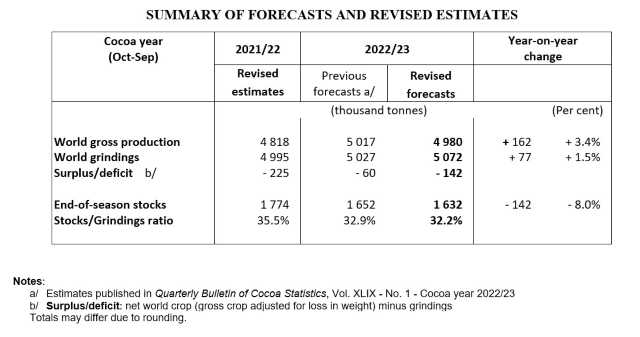ABIDJAN, Côte d’Ivoire – The International Cocoa Organization releases its revised forecasts for the 2022/23 cocoa year and revised estimates of world production, grindings and stocks of cocoa beans for the 2021/22 cocoa year. The data published in Issue No. 2 – Volume XLIX – Cocoa year 2022/23 of the Quarterly Bulletin of Cocoa Statistics, reflect the most recent information available to the Secretariat as at the beginning of May 2023.
The International Cocoa Organization quarterly bulletin
One certainty for the ongoing 2022/23 season is the occurrence of a supply deficit, although compared to the 2021/22 season, the 2022/23 global production is projected to increase by 3.4% to 4.980 million tonnes. Grindings are expected to rise by 1.5% to 5.072 million tonnes.
Although a positive growth in cocoa production is underway for the season under review, yields are likely to be impacted by the weather such as the looming El Niño as well as other factors including diseases, fertilizer inputs, husbandry practices among others.
With regards to the increase in cocoa grindings, the commentary of the Bulletin highlights the recent efforts by top producing countries to move towards the downstream products instead of exporting raw cocoa beans. Indeed, cocoa processing has held up well at origin and this may have caused unintended adverse consequences such as low exports of cocoa beans from top producing countries to importing countries.
Another market development pointed out in the Bulletin is the build-up of cocoa inventories at the exchange, despite the assurance of a supply deficit for the 2022/23 season. Certain possibilities alluded to the relatively high level of stocks at the exchange are mentioned.
A review of price developments on international markets for cocoa beans during the January-March quarter of 2023 is also presented.

Statistical information on trade in cocoa beans, cocoa products and chocolate, by country and by region, published in this edition, covers annual data from 2019/20 to 2021/22 and quarterly statistics for the period April-June 2021 to October-December 2022. Details on destinations of exports and origins of imports for leading cocoa exporting countries are also provided.
Copies of the Quarterly Bulletin of Cocoa Statistics, in Microsoft Excel and Adobe PDF formats, can be ordered from the ICCO e-Shop or by email: statistics.section@icco.org.
About ICCO
The International Cocoa Organization (ICCO) is an inter-governmental organization established in 1973 under the auspices of the United Nations and operating within the framework of successive International Cocoa Agreements. The ICCO is headquartered in Abidjan, Côte d’Ivoire.
The Organization comprises 52 Member countries, of which 23 are cocoa exporting countries and 29 are cocoa importing countries. These Member countries together represent 86% of world cocoa exports and 76% of world cocoa imports.
The ICCO seeks to promote and support the economic, social, and environmental sustainability of the cocoa value chain, and in particular to improve the living conditions of cocoa farmers. The Organization acts as a center for knowledge and innovation in the world cocoa economy; as a platform for institutional cooperation to foster dialogue among its Member countries and between key stakeholders in the cocoa value chain; and as a source of technical assistance for its Member countries.


















